On this page
- Introduction
- The Future Challenge
- Understanding our Medium Term Plan
- The planning assumptions/constraints we are working with
- About Hertfordshire and west Essex
- Snapshot of the Hertfordshire and West Essex ICS
- Our vision for Hertfordshire and West Essex
- Achieving our vision
- Achieving the three shifts in care
- Changing our model of care: implementing the East of England Model as part of our Medium Term Plan
- Our approach to delivery of our Medium Term Plan
- Our key enabling and delivery strategies
- How we will deliver
- The priorities of the Integrated Care Board 2024-2030
- Our approach to ensuring every child has the best start in life
- Our approach to increasing healthy life expectancy and reducing inequality
- Our approach to improving access to health and care services
- Our approach to increasing the number of residents taking steps to improve their wellbeing
- Our approach to ensuring we are financially sustainable
- 2024-2026 medium term plan transformation priorities
- Building our operating model – making decisions happen closer to our communities
- Appendix A: our system in 2024
- Appendix B: Our system in the future
Introduction
The NHS is seeking to meet the dual challenge of unprecedented demand for our services and significant financial constraints. Hertfordshire and West Essex Integrated Care System is no different, and this means that for 2024/5, and each year that follows, we will need to focus on a clear set of priorities through this medium term plan that will help us to meet both of those challenges.
In addition, we know that changes to the demographics of our population alongside an increase in the numbers of people living with multiple health conditions will further test both the services we provide and the budget which we have to provide them in the latter parts of this decade. Our system, which already has a higher proportion of over 85s than many others, will see a further steep incline in its older population over the next six years. This is cause for celebration, but it does mean that our services and approach will need to change to match the changing health and care needs of our residents.
Finally – we must not lose sight of the pockets of deprivation and health inequalities that exist in Hertfordshire and West Essex. Any plan that covers the remainder of this decade must demonstrate how the Integrated Care Board will level up people’s experience and outcomes from health and care to match those in our least deprived communities.
Our Medium Term plan describes our vision for Hertfordshire and West Essex and the key priorities and shifts in our care model we will need to focus on to achieve it. It doesn’t describe everything we are and will do as a system but is designed to set out clearly the areas we will focus our efforts and investment on in coming years. It also describes the journey we will follow to build our operating model – which is based on the principle that decisions should be taken as closely as possible to our residents.
Some of our priorities will be achieved through our active participation in the Integrated Care Partnership. Others will be delivered in partnership with other NHS organisations, our district, borough and county council colleagues, other public sector organisations and with our partners in the voluntary, community, faith and social enterprise sector. The detail on delivery of those priorities is set out in other strategies and plans that are referenced throughout this document.
The Future Challenge
The combination of health inequalities and an ageing population mean that demand faced by our health and care services outstrips their capacity, and this will only worsen without action. Appendix A and B set out more detail on our current and future challenge.
Changing Demographics
Demographic changes in Hertfordshire and West Essex mean that our older population will be growing rapidly over the coming 15 years or so, and it is this section of the population that are the most intensive users of health and care services.
We also predict seeing continuing levels of demand for support relating to mental health / wellbeing and in relation to childhood development (higher than were seen pre-pandemic).
Inequality
Whilst the population is (in general) less deprived than the national average, there are communities within each of our three place areas with much more significant deprivation, where health and other outcomes are not at the same level as other parts of the system.
Key partners across the system recognise both that the main factors affecting deprivation sit outside direct health & social care provision, and that health and care services can do more to better support more deprived populations.
Patient Experience
Repeated episodic care does less to enhance patient experience and outcomes, in some instances accelerating loss of self-confidence and increasing dependency.
Whilst specialisation of care brings advantages, it can make caring for people with multiple conditions more costly and less joined up.
Financial sustainability
·A combination of increased demand, greater acuity, demographic changes and broader economic challenges mean that the system has a recurrent, underlying financial deficit.
·Unless tackled, this will prevent the system from moving to the new model of care that is required for the future and will negatively impact on our residents.
Understanding our Medium Term Plan
This medium term plan will guide the work of the Hertfordshire and West Essex Integrated Care Board for the remainder of this decade. It is a response to the very urgent challenges we face now, and the demographic changes we will see over the next six years. It effectively has three key components:
The Hertfordshire and West Essex Vision
This section sets out in more detail the vision for Hertfordshire and West Essex that underpins our core mission:
Hertfordshire and West Essex ICB exists to work with others to build a future in which all our residents can live better, healthier and longer lives
The five medium-term transformation objectives that will support delivery of the vision:
These objectives will be delivered in a phased multi-year way, and the Medium-Term plan sets out the various pieces of work that will need to take place to achieve them. Work has already begun on all the areas set out in the plan, and there is more detail on this in the strategies and plans that have informed the creation of our Medium Term Plan.
Our 2024-2026 priorities:
Although work has begun on all the areas that are set out in this medium term plan, there are some that we need to prioritise now – this may be because there is an urgent need to improve performance for our residents (for example Urgent and Emergency Care, recovering our elective services and more support for those in mental health crisis), or because of the potential longer term benefits if we act now (A focus on CVD and hypertension) or because of the potential harm of not moving quickly (reducing backlogs in children’s care).
The planning assumptions/constraints we are working with
We will set clear measures of success for all the areas identified for improvement in this medium term plan. Some will relate to the longer-term shift in population health we would like to see, with others acting as shorter-term markers of success.
- Around 25% of the (non-elective) patients admitted to our hospitals could be cared for at home if their needs were met earlier or differently
- The New Hospital Programme presents an opportunity for the system to reset its current model of delivery but will mean that we have less beds across the system
- There is a system wide appetite to move towards proactive and preventative approaches that identify needs earlier and offers less intensive support to achieve better outcomes and enable people to live longer, healthier and happier lives
- A multi-partner whole system approach in areas of deprivation will improve residents’ health and wellbeing and to some extent reduce hospital demand.
About Hertfordshire and west Essex
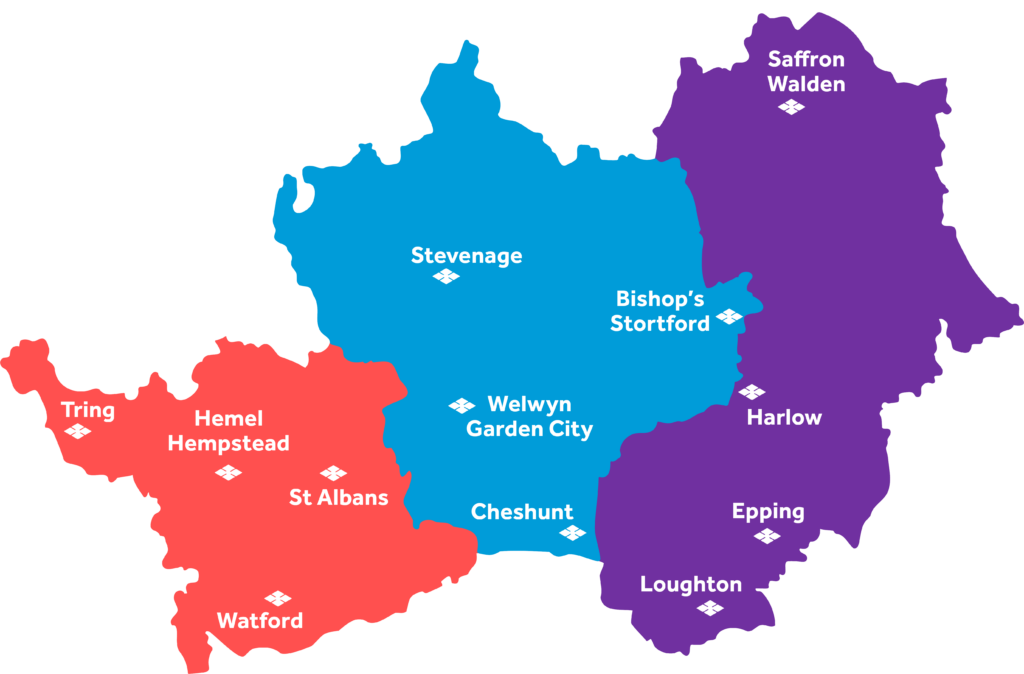
Snapshot of the Hertfordshire and West Essex ICS
Combined population of around 1.6 million people.
Health and Care Partnerships
- East and North Hertfordshire Health and Care Partnership
- South and West Hertfordshire Health and Care Partnership
- West Essex Health and Care Partnership
- Hertfordshire Mental Health, Learning Disability and Autism Partnership
- West Essex Mental Health Collaborative in development
Acute Trusts
- East and North Hertfordshire NHS Trust
- West Hertfordshire Teaching Hospitals NHS Trust
- Princess Alexandra Hospital NHS Trust
Community and Mental Health Trusts and organisations
- Essex Partnership University NHS Foundation Trust
- Hertfordshire Community NHS Trust
- Hertfordshire Partnership University NHS Foundation Trust
- Central London Community Healthcare NHS Trust
- North East London NHS Foundation Trust
- HCRG
Ambulance Trust
East of England Ambulance Service NHS Trust
NHS 111 provider
Primary Care
More than 130 GP practices in 41 Primary Care Networks
Local Authorities
- Hertfordshire County Council
- Essex County Council
- Broxbourne Borough Council
- Dacorum Borough Council
- East Herts Council
- Epping Forest District Council
- Harlow Council
- Hertsmere Borough Council
- North Herts Council
- St Albans City and District Council
- Stevenage Borough Council
- Three Rivers District Council
- Uttlesford District Council
- Watford Borough Council
- Welwyn Hatfield Borough Council
Health and Wellbeing Boards
Healthwatch
Other professional bodies, voluntary sector, community, faith and social enterprise organisations
Voluntary, Community, Faith and Social Enterprise (VCSFE) Alliance that covers ICS area
Our vision for Hertfordshire and West Essex
Hertfordshire and West Essex ICB exists to work with others to build a future in which all our residents can live better, healthier and longer lives. Critical to this will be ensuring that:
- Our whole system delivers high quality, fully integrated care that can be accessed easily and quickly.
- No patient is treated in a hospital setting when it would have been possible for them to receive their treatment at home or in their community.
- The quality of care, experience and outcomes of all Hertfordshire and West Essex residents matches the experience and outcomes of those who live in our least deprived areas, with a focus on tackling unwarranted variation across and within our HCP areas.
- Our system is proactive and as focused on interventions to prevent illness and reduce the risk of hospitalisation, as we are on the management of illness.
- We base our strategy and decisions on evidence and what’s been proven to work- with strategy designed at a system level and implemented by each HCP in a way that is tailored to the needs of residents.
- We move to a sustainable financial position as a system which enables us to shift funds away from acute care and into prevention and care in home or community settings.
Achieving our vision
To achieve our vision, we will focus on five ambitions:
- Increasing healthy life expectancy, and reducing inequality
- Giving every child the best start in life
- Improving access to health and care services
- Increasing the numbers of citizens taking steps to improve their wellbeing
- Successfully delivering our financial plan each year
Which will support three shifts in our model of care:
- From reactive acute care to preventive, anticipatory and community-based care
- From a siloed and poorly coordinated model to continuous, integrated care
- From a model based on providing care to one where active patients are engaged in self-management and collaborative care planning
In our first year we will prioritise:
- CVD and hypertension
- Reducing waiting times in targeted children’s services
- Reducing UEC demand by delivering more anticipatory/same day care
- Provide better care to people in mental health crises
- Continue our elective care recovery
Achieving the three shifts in care
The work that we will do to deliver our five ambitions will also support the 3 shifts required to our model of care to ensure we can meet the challenge of the changing demographics of our population.
Shift 1: From reactive acute care to preventive, anticipatory and community-based care
- A focus on preventing Cardiovascular disease and hypertension;
- Implementing the outcome of our Community Services review;
- Expanding frailty support;
- Working with partners to reduce drug and alcohol dependency
- Successfully delivering our suicide prevention strategy
Shift 2: From a siloed and poorly coordinated model to continuous, integrated care
- Targeted improvements in children’s services
- Improving same day access to Urgent and Emergency Care
- Expanding MH crises support
- Utilising the opportunity presented by the New Hospital programme
Shift 3: From a model based on providing care to one where active patients are engaged in self-management and collaborative care planning
- Data driven approaches to public health
- Being an active partner in the Integrated Care System as it works to reduce inequality
The Hertfordshire and West Essex Digital Strategy for 2022-2032 is a key enabler to these shifts in care.
Changing our model of care: implementing the East of England Model as part of our Medium Term Plan
‘Closing the Care Gap’ – NHS East of England
The vision for healthcare in the east of England is one that is readily accessible, seamlessly integrated and inclusive to all members of our community. A healthcare system that is simple to use, with services available whenever they are needed. Our priority is to empower individuals by placing access to care directly in their hands, offering user-friendly digital platforms and personalised support to navigate their healthcare journey with ease. Moreover, committed to creating an environment our workforce finds joy and fulfilment in their work, with opportunities for professional growth, meaningful collaboration and a shared sense of purpose in delivering high quality care. By prioritising accessibility, inclusivity and workforce satisfaction, the aim is to create a healthcare system that not only meets the needs of our community but enriches the lives of those who serve within it.
We will continue to develop our approach to implementing this model in 24-25.
Our approach to delivery of our Medium Term Plan
Working with our partners to deliver our shared priorities
The Medium Term Plan sets out the priorities and focus of the ICB, and our vision for Hertfordshire and West Essex in 2030.
In setting this plan we have ensured that all of our work will contribute to the delivery of the wider Integrated Care Strategy. The ICB and the Integrated Care Partnership are interdependent – we cannot deliver many of the aims of this plan without the ICP, and the ICP will not be as effective in achieving its priorities without the commitment of the ICB and the wider NHS. Our medium-term plan commits us to continuing to be full and active partners within the Integrated Care Partnership.
Our key non-NHS partners
Local Government
Our county, district and borough colleagues are critical to the adoption of our new model care, and we will continue, and build on, our joint work on the delivery of social care, the prevention of illness, public health management and much more.
Health and Wellbeing Boards
The Joint Health and Wellbeing Strategies of both the Hertfordshire and Essex Health and Wellbeing Boards have informed this Medium Term Plan and we will continue to work closely with them as we build our delivery approach.
Voluntary Sector, Faith and Social Enterprise Alliance
We are fortunate in Hertfordshire and West Essex to have a strong VCFSE alliance and we are one of only a small number of ICBs who have a representative of the sector as a full board member. The alliance is crucial to the delivery of the MTP and we look forward to continuing to work in partnership with them.
Our key enabling and delivery strategies
In addition to the strategies that focus on delivery of our priorities directly, we have a number of enabling strategies that help to develop the right conditions for the delivery of the plan. They will be developed further over time to ensure full alignment with the Medium Term Plan. These include:
The Integrated Care Strategy
The ICB continues to be an active participant within the ICP, which is critical to delivery of much of the Medium Term Plan.
Enabling Strategies – create the conditions that enable delivery of the Medium Term Plan
- HWE People Plan – This strategy supports integrated workforce planning, innovation and new ways of working, a sustainable workforce supply, improved staff wellbeing, experience, and education, talent, and leadership development.
- HWE Digital Strategy – This strategy covering health service provision focuses on enabling our professionals to transform services to meet the needs of our residents. It will do this by providing the right digital capabilities, including technology and infrastructure. It is these capabilities that will enable those that provide care to work together to create the best outcomes for people living in Hertfordshire and west Essex. It will enable improved access for residents, patients, and service users to information about themselves and allow them to interact digitally with their clinical and care professionals when it is appropriate and convenient to do so.
- HWE Primary Care Strategy – Our strategy to develop GP, community pharmacy, dentistry, and ophthalmology services across Hertfordshire and west Essex to benefit patients and communities over the next three years.
- Health Creation Strategy – VCFSE Alliance – This strategy has been co-designed with the Voluntary, Community, Faith and Social Enterprise (VCFSE) Alliance , utilising VCFSE organisations to promote health and wellbeing and addressing the wider determinants of health. It ensures that VCFSE partnership is embedded as an essential part of how our system operates at all levels and promotes a more joined up and strategic approach to commissioning of the sector based on evidence of need and impact.
- Financial Strategy
Delivery Strategies – provide the detail on how the Medium Term Plan will be achieved
- Joint Forward Plan
- UEC strategy
- Elective Recovery Strategy
- Planned Care Strategy
- Cancer Strategy
How we will deliver
Our vision and objectives are set by the Medium Term Plan and the Integrated Care Strategy.
We plan once, set clear expectations and outcomes – doing things once where it makes sense to do so, for example in data analytics.
Health and Care Partnerships will deliver agreed improvements, tailoring plans to local knowledge and circumstance and also identify additional areas for improvement.
UEC and same day urgent care example
From the Medium Term Plan – aim to give everyone in Hertfordshire and West Essex access to same day urgent care as needed.
We set the strategy and identify what should be delivered once across the system. The guiding delivery strategy is:
Urgent and Emergency Care (UEC) strategy – Sets out plan to move to an integrated 24/7 urgent care service, timely and appropriate access to diagnostics, integrated community pharmacies with UEC model, consistent, locally led pathways of care, greater treatment of patients through non admitted same day emergency care pathways
The relevant enabling plans are:
- Digital strategy (supportive of improved pathways including digital triage)
- People plan (growing skills and capacity to support new pathways and models of care
- Primary Care strategy (looks to simplify and enhance access for urgent primary care needs)
- Financial plans (supports implementation of community service strategy
Health and Care Partnerships will deliver agreed improvements, tailoring plans to local knowledge and circumstance and also identify additional areas for improvement.
The priorities of the Integrated Care Board 2024-2030
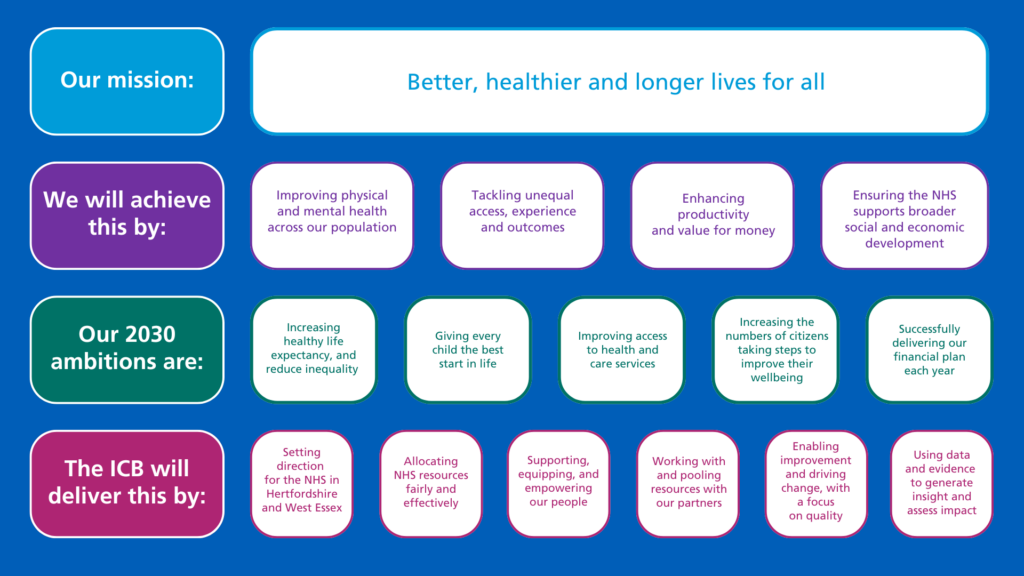
Our mission
Better, healthier and longer lives for all
We will achieve this by
- Improving physical and mental health across our population
- Tackling unequal access, experience and outcomes
- Enhancing productivity and value for money
- Ensuring the NHS supports broader social and economic development
Our 2030 ambitions are
- Increasing healthy life expectancy, and reduce inequality
- Giving every child the best start in life
- Improving access to health and care services
- Increasing the numbers of citizens taking steps to improve their wellbeing
- Successfully delivering our financial plan each year
The ICB will deliver this by
- Setting direction for the NHS in Hertfordshire and West Essex
- Allocating NHS resources fairly and effectively
- Supporting, equipping, and empowering our people
- Working with and pooling resources with our partners
- Enabling improvement and driving change, with a focus on quality
- Using data and evidence to generate insight and assess impact
Our approach to ensuring every child has the best start in life
What we will do
We want to see improvements in the health of our children and young people, setting them up for their best future life. We will:
- tackle health inequalities and promote the prevention of ill health to ensure that all children receive high-quality care and are supported to live a healthy life both physically and emotionally
- work together to ensure that children with long term conditions or complex care needs are supported to achieve their fullest potential
- change the way we work together to provide care that is easy to access and integrated, which places the child or young person and their family at the heart of our planning
- ensure that care is personalised and provided as close to home as possible, recognising the role of the community in children’s lives supporting them to achieve their goals.
Between 2024 and 2030 our focus will be on
- Reducing waiting times in targeted children’s services (ASHS / ASD system wide, community paediatrics, paediatric audiology), by building on current plans and redirecting resources
- Improving services for children with Special Educational Needs and Disability (SEND) through our work with local government partners
- Improving emergency pathways for children – as set out in our Urgent and Emergency Care Strategy
- Continuing our system journey of improvement in Maternity Services, with a focus on implementing the six elements of ‘Saving Babies’ Lives Care Bundle’
- Improve paediatric access to NHS dentistry.
What our residents can expect
- A reduction in the numbers of stillbirths and deaths in the first week of life
- Fewer 5-year-olds with tooth decay
- Reduced waiting lists for neurodiversity services
- Decreased waiting times across all community paediatric services
- Reduced emergency admissions for all children under 18
- Increased utilisation of virtual wards and other approaches to support children to have hospital level care in their own home.
Our approach to increasing healthy life expectancy and reducing inequality
What we will do
Through our work in the Integrated Care Partnership, with our communities and through own work:
- Reduce health inequalities to improve our residents’ health and wellbeing
- Take positive action on the wider determinants of health, including housing, employment and the environment
- Ensure we adopt a data driven approach to prioritise work and approaches that will have the biggest public health impact.
Between 2024 and 2030 our focus will be on
- Continuing to play an active role in the work of the Integrated Care Partnership, supporting delivery of its priorities
- Redeploy more of our resources on preventing and treating Cardiovascular disease, hypertension and Lipids
- Growing our Tobacco dependency reduction programme – to achieve a smoke-free system
- Strengthening our work with system partners to reduce drug and alcohol dependency
- Working with local Governance and VCFSE colleagues to support healthy ageing
- Successfully delivering our suicide prevention strategy
- Taking targeted action across our HCPS to tailor approaches to delivering the above to local need.
What our residents can expect
- An increase in life expectancy across our system
- A lower rate of mortality from all cardiovascular disease
- An increase in the number of GP recorded hypertension patients with a blood pressure reading within the target range
- A fall in the rate of suicide across Hertfordshire and West Essex
- Targeted work to identify patients with hypertension in our most deprived communities.
Our approach to improving access to health and care services
What we will do
We will ensure that residents of Hertfordshire and West Essex are able to get the help that they need, from the best place or health and care service, at the right time by:
- Developing ways of working that streamline care, providing a better experience for patients, carers and staff
- Working as a system to ensure we have the right model of care to support this
- Making it easier to connect people to the “best” service – rather than the “most obvious” service – ensuring the right people have access to care in the right place and at the right time
- Continue to implement our Primary Care Strategic Delivery Plan for 23-26.
Between 2024 and 2030 our focus will be on
- Ensuring system wide same day access to Urgent and Emergency Care
- Expanding our MH crisis support / CAMHS services to ensure they meet present and future need
- Continuing our work to recover elective care services
- Delivering sustained improvement in cancer services
- Ensuring we achieve the maximum benefit of new Community Diagnostic Centres and elective hubs for patients
- Improving the experience of those at the end of life.
What our residents can expect
- Faster access and delivery of cancer services in line with the cancer standards
- Quicker access to diagnostic tests
- Shorter waits for planned care
- Easy and rapid access to same day or urgent care as needed
- Less emergency hospital admissions for intentional self-harm across the system
- An enhanced response to urgent referrals to community crisis services
- A reduced uses of inappropriate out of area placements for mental health patients.
Our approach to increasing the number of residents taking steps to improve their wellbeing
What we will do
Our approach to ensuring that our residents are taking steps to improve their wellbeing is through our role as an active partner in the Integrated Care Partnership. The partnership is committed to:
- Develop a new physical activity offer for our residents
- Support our residents in low-income households to have access to affordable healthy food and facilities to store and cook it
- Support our residents most at risk of poor outcomes from being overweight including those with mental health conditions, physical disability or learning disability and autism
- Support children and young people to have access to information, advice, and support to maintain a healthy weight and access to leisure activities in their communities, to support the importance of tackling childhood obesity.
Between 2024 and 2030 our focus will be on
- Working with our system partners to successfully deliver the relevant parts of the Integrated Care Strategy for Hertfordshire and West Essex
- Tackling frailty, which is crucial given our future demographic changes as a system. We will deliver the changes we set out in our UEC strategy to achieve this – implementing improved clinical pathways, introducing an integrated acute frailty service, and strengthening our out of hospital care.
What our residents can expect
- Fewer people admitted to hospital as a result of a fall
- Access to physical activity offers
- A universal support offer for those looking to stop smoking
- Targeted support for those who are on low incomes
- More access to information that will help them stay healthy and improve their wellbeing.
Our approach to ensuring we are financially sustainable
What we will do
- We will use the resources available to us as best we can – to maximise the benefits for residents and staff, setting ourselves the twin challenge of being both more productive and efficient as a system. This will be guided by our medium-term financial plan
- Key to our financial sustainability, and the delivery of all of our objectives is our workforce. We will continue to implement the NHS Long term workforce plan alongside the Hertfordshire and West Essex People Plan
- With well-advanced and supported plans for large scale capital developments, we must use this once in a generation opportunity to invest wisely for today and for years to come.
Between 2024 and 2030 our focus will be on
- Using a data driven approach to improve the productivity of elective care pathways, focusing on our five high impact changes based on a ‘Best in HWE Benchmark’
- Making better use of workforce data and digital innovation to support workforce productivity and efficiency
- Developing primary and community workforce to ensure more care takes place in the home / community
- Implementing a new model of Out of Hours and Community Services which is underpinned by a new contractual framework focused on improving outcomes and tackling variation
- Focusing on those that are most likely to suffer deteriorating health leading to a need for urgent or emergency care, preventing where this is possible and ensuring same day access is integrated, easily accessible and safe
- Implementation of the ICS estates strategy
- Developing a local workforce pipeline in line with workforce clinical expansion targets, support better retention of our workforce and reduce agency spend
- Achieving financial balance annually (NHS)
- Designing and delivering a system wide agreed plan to maximise the benefits of the £2bn capital investment New Hospital Programme.
What our residents can expect
- More care taking place at home or in the community
- For the system to maximise the productivity of our operating theatres and outpatients’ services
- Develop a local workforce pipeline in line with workforce clinical expansion targets, support better retention of our workforce and reduce agency spend
- A decrease in the amount of money we need to spend on urgent and emergency care
- A fall in our annual spend on agency staff to cover vacancies
2024-2026 medium term plan transformation priorities
The Integrated Care Board has five key transformation priorities for the next two years. The delivery plans of our Health and Care Partnerships will set out our approach to achieving them. These transformation priorities will support delivery of our longer ambitions and assist in achieving our 6th priority for 24/25 – delivering our financial plan.
| Priority | Expected Outcome | Success Measures |
| Reduce inequality with a focus on outcomes for CVD and hypertension | Reduce under 75 mortality from long term conditions | • 2% increase in hypertension QOF measures (March 2026) • Increase the % of patients with GP recorded hypertension whose last blood pressure was in target to 80% • Increase the age of standardised prevalence of hypertension in the most deprived 20% of the population from 17.6% to 19% (March 2026) |
| Improve UEC through more anticipatory/SDEC care | Reduce the rate of unplanned hospitalisations for chronic ambulatory care | • Decrease the rate of emergency admissions for falls within the community for people aged 65+ by 5% (March 2027) • Reduce the % of deaths with 3 or more emergency admissions in the last 90 days of life ( all ages) from 6% to 5% across Herts and West Essex by March 2027 |
| Better care for those in Mental Health crisis | Increase in the provision of early help to prevent mental illness and support the health and wellbeing of those with severe mental illness, learning disabilities or autism. | • Increasing our response to urgent referrals to Community Crises Services in 24/25 from 64% to 67% • Reduce the use of out of area inappropriate beds for adults requiring a mental health inpatient stay across the ICS from 16 people to 4 people by March 2025 • 75% of inpatient discharges to have 72 hour follow up by March 2025 |
| Elective care recovery | Reduction in the numbers waiting for elective activity and diagnostics | • Reduce number of patients waiting more than 65 weeks for treatment, to 0 by 30th Sept 2024 • 85% of surgery across HWE is consistently undertaken as day case by March 2026 • Reduce the number of patients waiting more than 6 weeks for diagnostic services year on year and by March 2025 ensure that 95% of patients have their diagnostics within 6 weeks |
| Children’s care backlog reductions | All children will have the best start and live a healthy life | • Reduction in wait for community paediatric services to 65 weeks by April 2026 • Reduction in ED attendance and admission rates for children and young people by 5% (2028) |
Building our operating model – making decisions happen closer to our communities
In April 2024 our Health and Care Partnerships will become a more formal part of our system. This will mean that:
- The role and ways of working of the partnerships will be underpinned by an MOU and they will have a clearer place within the ICB’s governance
- Financial, performance, quality and workforce data will be developed and aligned to support HCP decision making – this will be a priority for the ICB
- A provider CEO will take formal responsibility for the leadership of the HCP and developing and maintaining the relationships and ways of working critical to its success
- All of the work of the HCPs will be underpinned by a Population Health Management Approach underpinned by the new data platform.
Throughout 24/25 the main task of our HCPs will be to implement delivery plans around our five 24/25 transformation priorities and the delivery of our financial plan.
Our future operating approach
To support our vision of decisions about health and care being taken as close to the end user as possible, except where there is the benefit of our scale, our system’s target operating model is one where the ICB’s role will be:
- Coordinating strategic planning across the system
- Delivering the statutory functions of the ICB
- Taking decisions which have ramifications for the whole system – for example whole system service design or procurement
- Assurance around the performance of HCPs
- A focus on tackling inequalities – using Public Health Management data analysis and Evidence Based Interventions
The HCPs’ role will be:
- To be a key part of developing the system strategy
- To have responsibility for the delivery of the strategy within their HCP areas.
- To have the duty of oversight for finance, performance, quality and commissioning of services within their HCP
- To have fully devolved budgetary responsibility for their local population A focus on tackling inequalities – utilising their local understanding using PHM data to drive service redesign
Achieving this approach
Our target operating model will require a significant shift in our current culture, operational approach and governance. We recognise that given the different starting points of our HCPs, some will move faster than others towards achieving this target state.
There are several models by which we can achieve the empowerment of the HCPs we wish to create through this model. All of those models would see a shift of responsibility and accountability from the ICB to HCP partners.
Recently launched NHSE guidance has helped to clarify the process for delegation and has confirmed that ICBs can follow two models in delegation – a lead provider model and committee in common. The merits of both models will be considered in 24/25.
Irrespective of the final model agreed, HCP take on budgetary and contractual responsibility for the delivery of HCP duties within their HCP footprint. This would be underpinned by a partnership agreement between the ICB, the provider and the members of the Health and Care Partnership.
Appendix A: our system in 2024
Life expectancy gap between the most and least deprived
| Male | Male | Female | Female | |
| 2017 – 19 | 2020-21 | 2017 – 19 | 2020-21 | |
| HWE | 6.2 | 6.4 | 4.5 | 5.2 |
| East of England | 6.7 | 7.2 | 5 | 5.8 |
| England | 7.8 | 8.6 | 6.3 | 7.1 |
The life expectancy gap between the least deprived and most deprived populations is 6.4 years for males and 5.2 years for females in HWE. The latest data shows an increase in the gap in line with what has been seen nationally and regionally. The gap remains smaller in HWE compared with the regional and national.
This illustration on the right shows the breakdown of the causes that contribute to the life expectancy gap between people living in the most and least deprived areas of Hertfordshire and West Essex.
This particular update shows the impact of Covid during 2020 to 2021.
Data shows that Circulatory Disease and Cancer contribute the most to the life expectancy gap between the most and least deprived. These areas are identified within our clinical and strategic priorities of the ICB.
Breakdown of life expectancy between the least deprived quintiles of NHS Hertfordshire and West Essex by cause of death, 2020 to 2021.
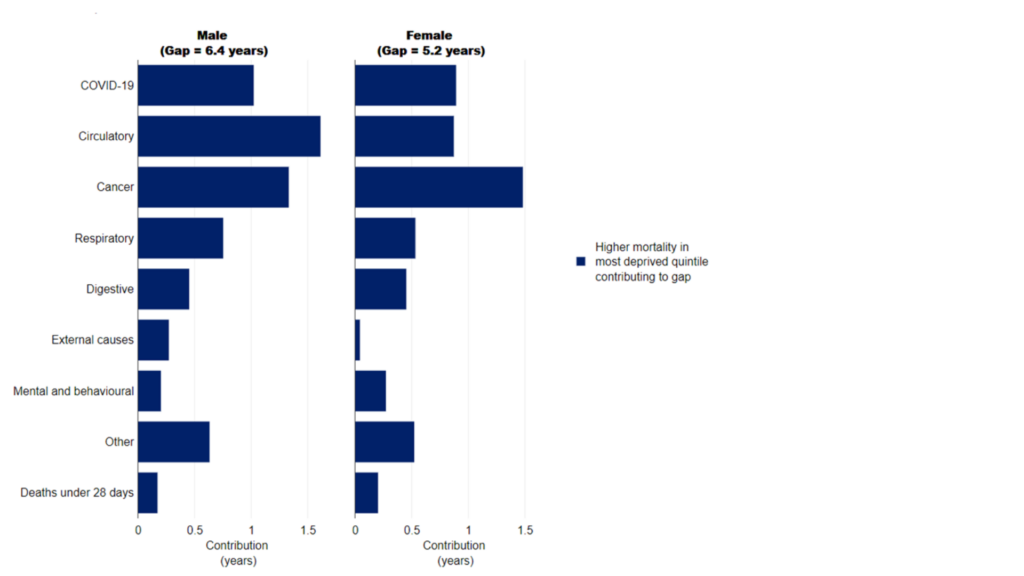
Life expectancy – variation at local level
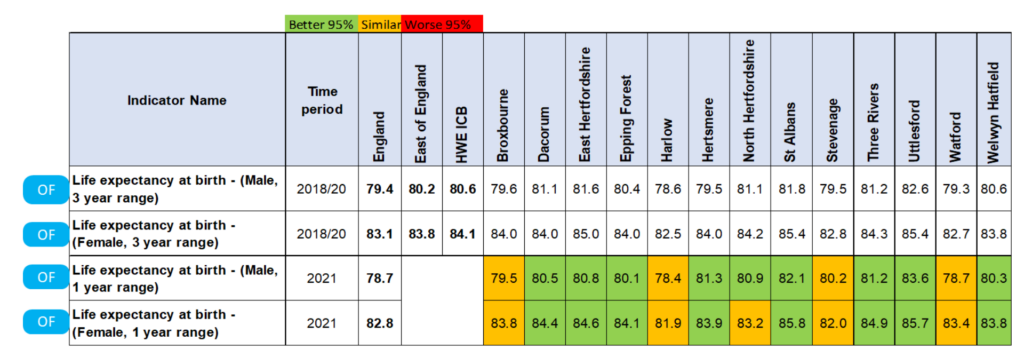
- Overall life expectancy and healthy life expectancy for the ICS masks variation within communities and HWE
- HWE overall Life Expectancy is higher than regional and England. Urban areas experience lower average life expectancy for both males and females, with residents in Harlow experiencing the lowest average life expectancy for both males and females
- The 2021 update for one year life expectancy shows an improved position for females in Harlow. This was previously categorised as significantly worse than the England value, however the latest data shows similar to England
- Absolute trends will be updated later in the year as Fingertips methodology is updated to reflect the latest census.
Healthcare and premature mortality
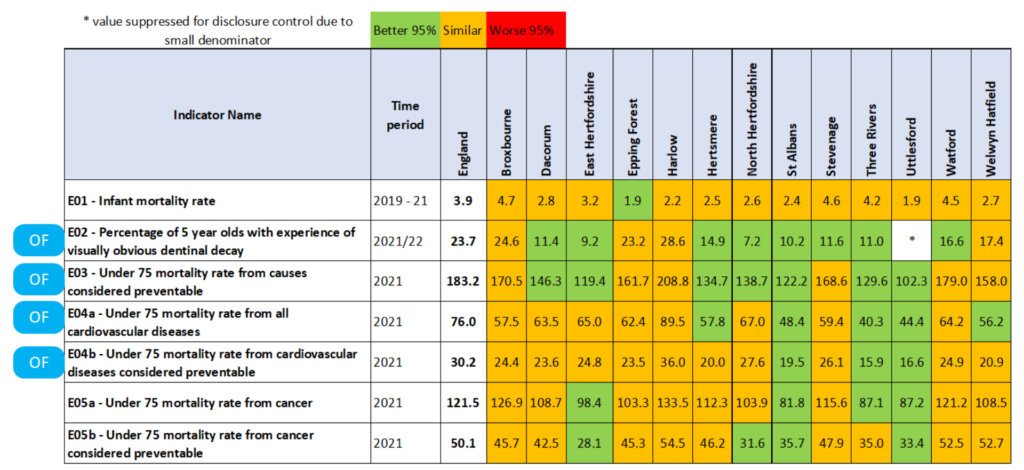
- Premature mortality by different conditions for the ICS remains similar or better than the England position
- Cardiovascular premature mortality trend is marginally worse for England but has remained similar for Hertfordshire and West Essex
- Areas with higher levels of deprivation in general experience poorer outcomes within the ICS. As previously observed Broxbourne, Harlow, Stevenage, Watford and Welwyn Hatfield have similar outcomes and are similar in terms of demographic features.
Healthcare and premature mortality
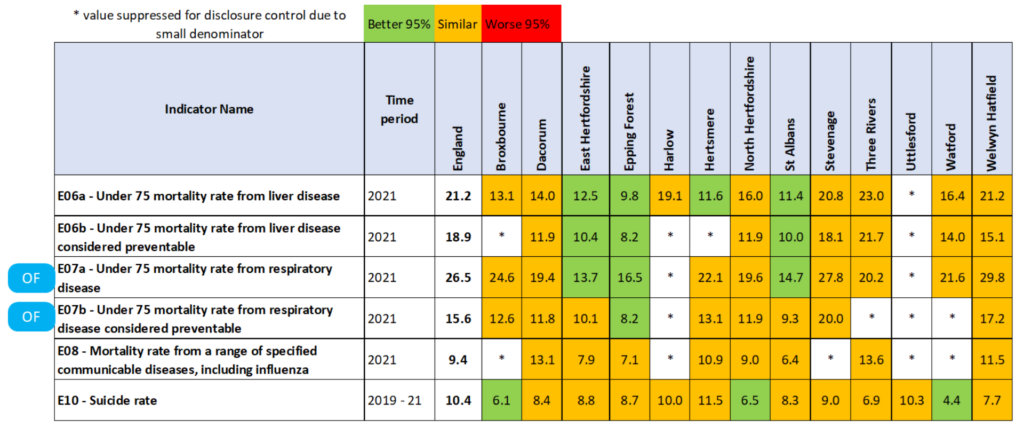
- Further indicators for Premature mortality by different conditions shows the ICS is similar or better than the England position.
- Latest suicide data shows an improvement in rates in Harlow.
Healthcare and premature mortality
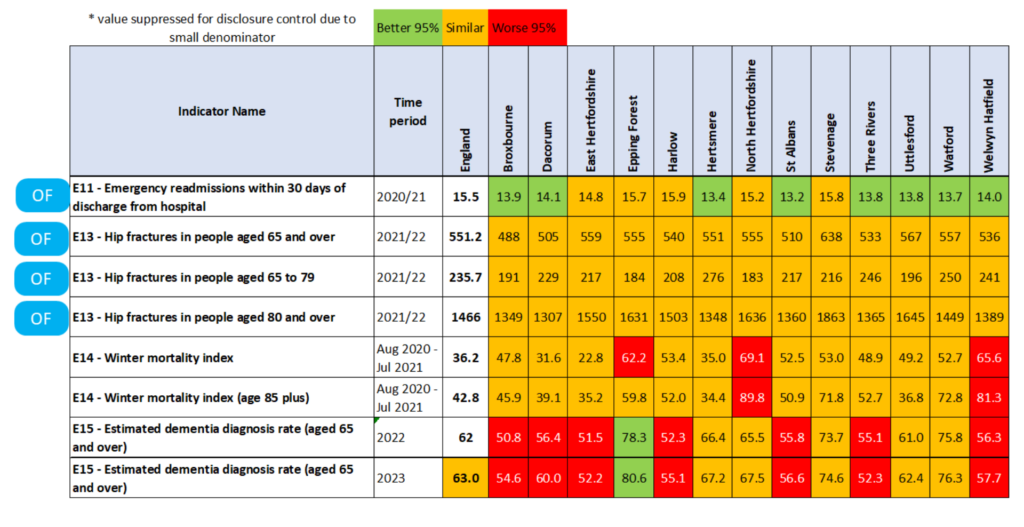
- In general the majority of indicators are similar or better than the England rate
- A small number of indicators are statistically worse than the national average in some districts within the ICS for winter mortality
- Post-Covid the estimated dementia diagnosis rate has opportunity for improvement in 7 districts within the ICS. The latest % winter mortality index covers the period of the Covid pandemic. The data shows Epping Forest, North Hertfordshire and Welwyn Hatfield with significantly higher number of deaths than the national.
Appendix B: Our system in the future
Demographic profile and segmentation
GP registered population pyramid for Hertfordshire and west Essex, compared to national for August 2023
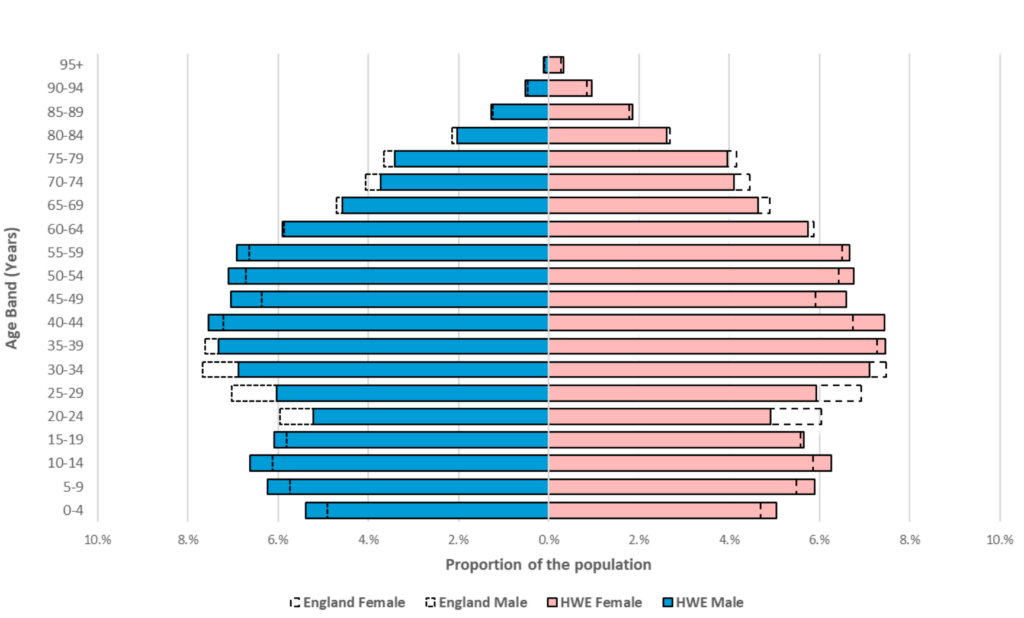
- Compared to the national average, the HWE ICS has a higher proportion of the population aged over 85 years, and a higher proportion aged under 20 years
- Younger adults (20-34 years) make up a smaller proportion of the population, whilst older working age adults make up a greater proportion of the population
- The registered population in HWE ICS has increased by 1.33% in the last 12 months, compared to a 1.35% increase nationally
- Source: Patients registered at a GP Practice Dashboard – August 2023.
Population projections for HWE ICB, split by age group, 2018-2043
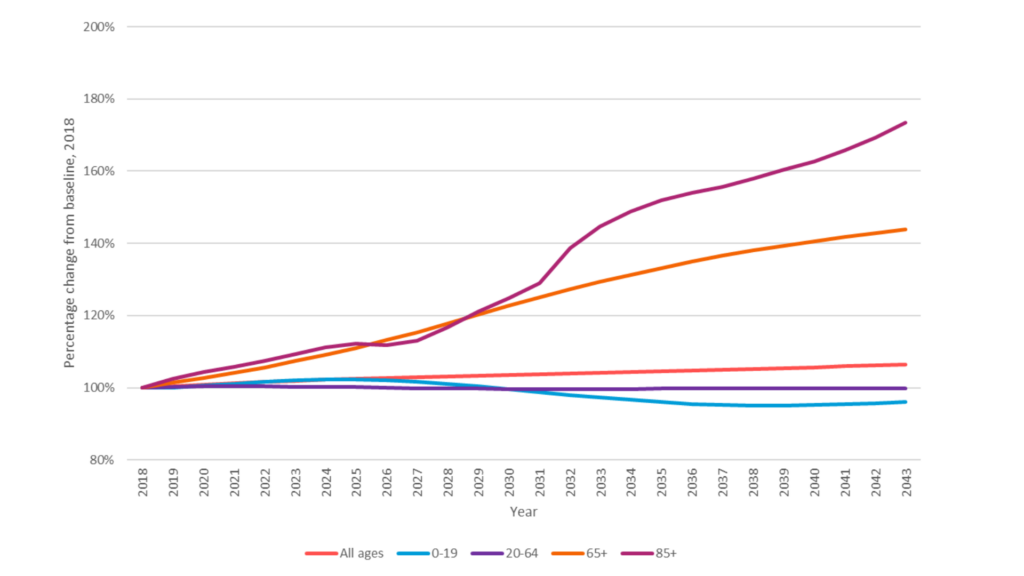
- The population of the HWE ICB is expected to increase by 6% overall between 2018 and 2043.
- There will be significant differences in growth across age bands
- Whilst there will be limited growth (or reductions) in children and working age adults, there will be significant growth in over 65 year olds and very significant growth in over 85 year olds
- There is a sharp incline in the number of people aged over 85 years after 2030 as ‘baby boomers’ age.